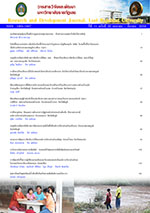การวิเคราะห์หน่วยทางวากยสัมพันธ์ : ของพาดหัวโฆษณาจากหนังสือเดอะบางกอกโพสต์
Keywords:
หน่วยทางวากยสัมพันธ์, พาดหัวโฆษณา, หนังสือพิมพ์เดอะบางกอกโพสต์, syntactic units, advertisement headlines, The Bangkok PostAbstract
Abstract in Thai unavailableAn analysis of the syntactic units : in the advertisement headlines in the Bangkok Post
The purposes of this study were 1) to analyze the syntactic units used in the advertisement headlines in the Bangkok Post, and 2) to analyze the types and forms of the syntactic units used in the advertisement headlines in the Bangkok Post. Totally 158 advertisement headlines used in this syntactic analysis were drawn from the Bangkok Post issued in 2014 between July to December. Three research instruments comprised: 1) the table for the hierarchy of the syntactic units, 2) the table for the units classified by types of construction and 3) the table for the units classified by syntactic forms. The content analysis method, means, and percentage were used in analyzing data. The study found that: 1. the syntactic units commonly used as the headline were phrases, sentences, words and clauses, respectively. 2. In the study of types and forms of syntactic units used: 1) as for the types; (1) four types of phrases commonly used were noun phrases, verb phrases, adverb phrases and prepositional phrases, respectively. (2) Four types of sentences that founded were declarative, exclamation, imperative and interrogative sentences. (3) All words were nouns. (4) Also, all clauses used were noun clauses. 2) For the syntactic forms; (1) most of phrase types used could be directly classified under the framework of parts of speech, still they were some phrases formed from the non- finite verbs; such constructions mostly used were gerund phrases, participial phrases and infinitive phrases, respectively. (2) Sentences founded could be classified in 4 forms; most of which were simple sentences, complex sentences, compound sentences and sentence fragments, respectively. (3) Every word used could be classified under the framework of the parts of speech; none of those forms from the non-finite verbs were used. (4) Clauses founded were those of main and subordinate clauses in complex sentences that curtain elements had been left out.
Downloads
How to Cite
Issue
Section
License
ข้อความที่ปรากฎในวารสารฉบับนี้เป็นความคิดเห็นของผู้เขียนแต่ละท่าน สถาบันวิจัยและพัฒนา มหาวิทยาลัยราชภัฏเลย และกองบรรณาธิการ ไม่จำเป็นต้องเห็นด้วยและไม่มีส่วนรับผิดชอบใดๆ
สถาบันวิจัยและพัฒนา มหาวิทยาลัยราชภัฏเลย ขอให้ผู้อ่านอ้างอิงในกรณีที่ท่านคัดลอกเนื้อหาบทความในวารสารฉบับนี้






